Volubilis: The Best-Preserved Roman Ruins in Morocco
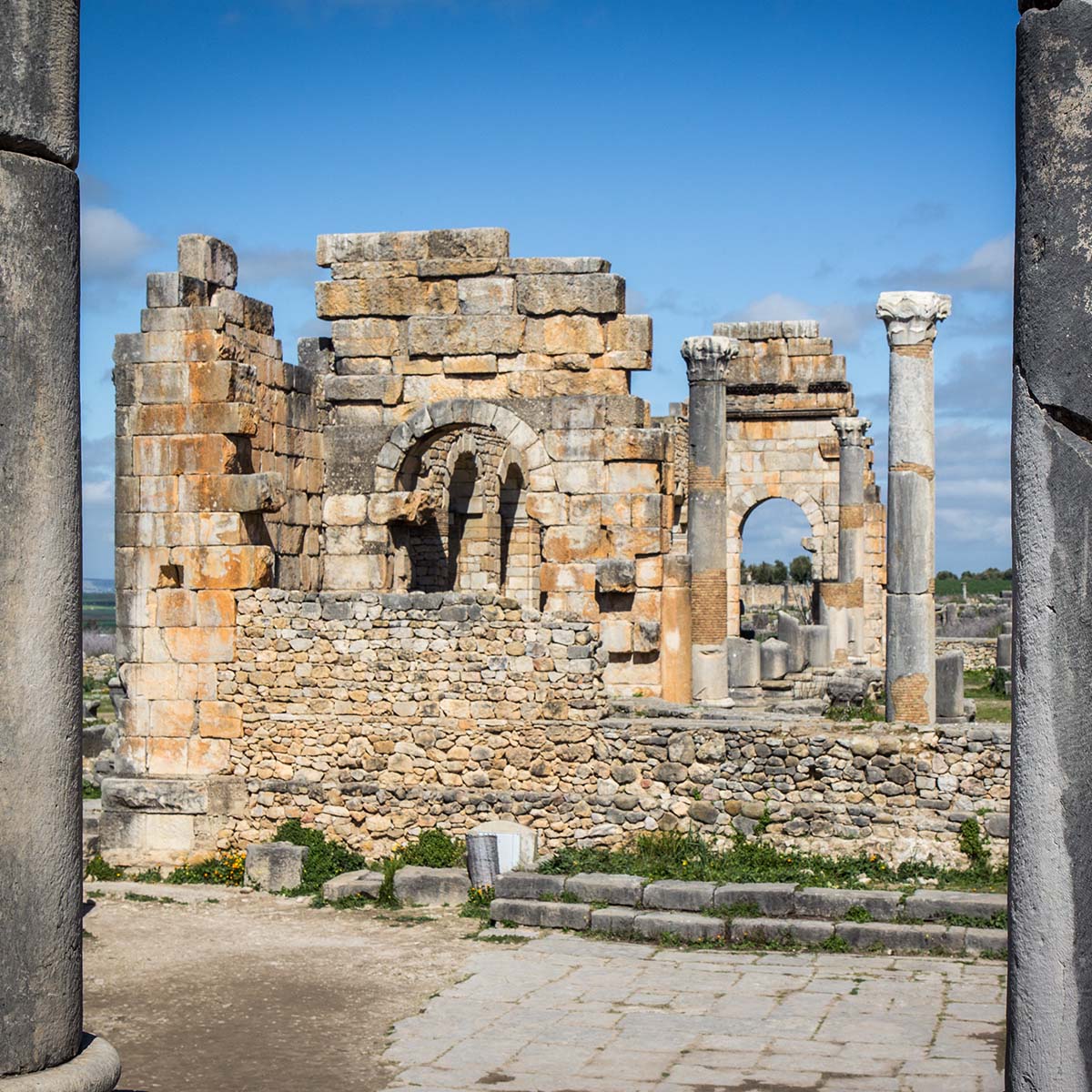
I. Introduction to Volubilis
Location and historical significance of Volubilis
Volubilis is an ancient Roman city located in present-day Morocco, near the city of Meknes. It is considered one of the best-preserved Roman ruins in the country and has significant historical and archaeological importance. The Berbers originally inhabited the site of Volubilis, which later became a thriving Roman settlement.
The city is strategically located in the fertile plains of the Zerhoun region, making it an important centre for trade and commerce in the Roman Empire. It was also a prosperous city for producing olive oil and agricultural products.
Importance of the site in Roman times
During Roman times, Volubilis was an influential and wealthy city, with a population estimated to be around 20,000 inhabitants. The city flourished between the 2nd and 3rd centuries AD and was a Roman culture and civilization centre in North Africa.
The city's prosperity is evident in its well-preserved buildings and structures. Many of the impressive ruins, including the Triumphal Arch, the Capitol, the Basilica, and numerous villas, showcase the architectural and artistic achievements of the Roman Empire.
Volubilis was also a melting pot of cultures, influenced by the indigenous Berber population and the Roman colonists. The city had a diverse population, and evidence of Roman lifestyle and beliefs can be seen in the intricate mosaics, beautifully decorated houses, and temples dedicated to Roman deities.
Excavations at the site have provided valuable insights into the daily life, trade, and governance of a Roman city in North Africa. The discoveries made at Volubilis have contributed greatly to our understanding of Roman civilization and its regional influence.
To this day, Volubilis remains an important historical and archaeological site, attracting visitors from around the world. Its well-preserved ruins and captivating history offer a unique glimpse into the grandeur of the Roman Empire in Morocco.
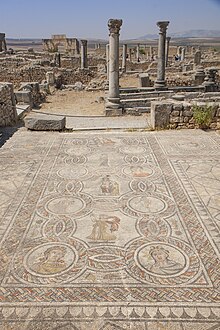
II. Architecture and Structures in Volubilis
Overview of the Roman Architecture in Volubilis
Volubilis is a UNESCO World Heritage Site in Morocco known for its impressive collection of Roman ruins. The ancient city was once a thriving Roman settlement and is a significant historical and archaeological site today. The Roman architecture in Volubilis showcases the influence and grandeur of the Roman Empire during its peak.
The architecture in Volubilis is a blend of Roman and indigenous styles, reflecting the cultural fusion that occurred during the Roman occupation of the region. The structures in Volubilis are characterized by their elaborate design, intricate carvings, and durable construction, which have stood the test of time.
Highlights of the structures, such as the Arch of Caracalla and House of Orpheus
One of the main highlights of Volubilis is the Arch of Caracalla, which was erected to honour the visit of the Roman Emperor Caracalla in the 3rd century. The arch stands as an imposing entrance adorned with intricate carvings and inscriptions. It serves as a testament to the Romans' architectural skills and artistic prowess.
Another notable structure in Volubilis is the House of Orpheus, a well-preserved residential building showcasing the inhabitants' daily life. The House of Orpheus features beautifully decorated mosaic floors depicting scenes from Roman mythology, such as Orpheus playing his lyre. It provides a glimpse into the opulence and sophistication of the Roman elite living in Volubilis.
Numerous other structures within the ancient city are worth exploring. These include:
- The Capitol
- The Basilica
- The Triumphal Arch
- The Decumanus Maximus (main street)
- The Roman Bath Complex
- The House of the Ephebus
- The House of Columns
Each of these structures offers unique insights into the architectural techniques and lifestyle of the ancient Romans. They serve as a visual reminder of the grandeur and influence of the Roman Empire during its reign.
Visiting Volubilis allows visitors to step back in time and immerse themselves in the rich history and magnificent architecture of the Roman era. It is a must-visit destination for history enthusiasts and those seeking to explore the ancient wonders of Morocco.
To learn more about Volubilis, you can visit its Wikipedia page for further information.
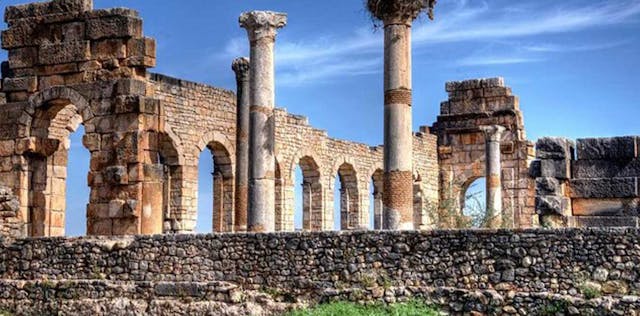
III. Mosaics and Artifacts in Volubilis
Detailed exploration of the exquisite mosaics found in Volubilis
Volubilis is renowned for its exceptional collection of Roman mosaics, which provide valuable insights into the daily lives and artistic achievements of the inhabitants of this ancient city. Here are some of the most notable mosaics found in Volubilis:
1. The Triumphal Arch Mosaic: This grand mosaic near the city's entrance depicts a triumphal arch with equestrian and infantry figures. It showcases the military victories of the Roman Empire and is an impressive testament to the artistic skill of the time.
2. The Orpheus Mosaic: This vibrant mosaic portrays the mythological figure Orpheus playing his lyre to captivate the animals. It's intricate details, and vibrant colours make it a captivating piece of ancient art.
3. The Diana and Actaeon Mosaic: Depicting the Greek mythological story of Diana and Actaeon, this mosaic showcases the hunting goddess and the hunter who stumbled upon her bathing. The level of detail and the graceful portrayal of the figures are a testament to the skilled craftsmanship of the artists.
4. The Four Seasons Mosaic: This mosaic represents the four seasons, each personified by a female figure. It is a beautiful portrayal of the changing cycles of nature and the passage of time.
Discussion of other significant artefacts discovered at the site
In addition to the breathtaking mosaics, Volubilis has also yielded a wealth of other artefacts that provide valuable insights into the ancient city's daily life, culture, and economy. Some of these significant artefacts include:
1. Statues and Busts: Various statues and busts have been unearthed at Volubilis, depicting emperors, gods, and other important figures. These sculptures offer a glimpse into the religious and political beliefs of the ancient inhabitants.
2. Inscriptions: Numerous inscriptions have been found at Volubilis, including dedicatory inscriptions, tombstones, and records of public buildings. These inscriptions provide valuable historical information about the city and its inhabitants.
3. Pottery and Glassware: Excavations have uncovered many pottery and glassware, including bowls, vases, and lamps. These artefacts offer insights into the daily life, cuisine, and trade practices of the people who lived in Volubilis.
4. Tools and Household Items: Archaeologists have also discovered various tools and household items, such as agricultural implements, cooking utensils, and jewellery. These artefacts shed light on the ancient inhabitants' everyday activities and material culture.
It is fascinating to explore the mosaics and artefacts found in Volubilis, as they provide valuable glimpses into the rich history and cultural achievements of the Roman civilization that thrived in this ancient city. To learn more about Volubilis and its significance, visit the Wikipedia page about Volubilis.
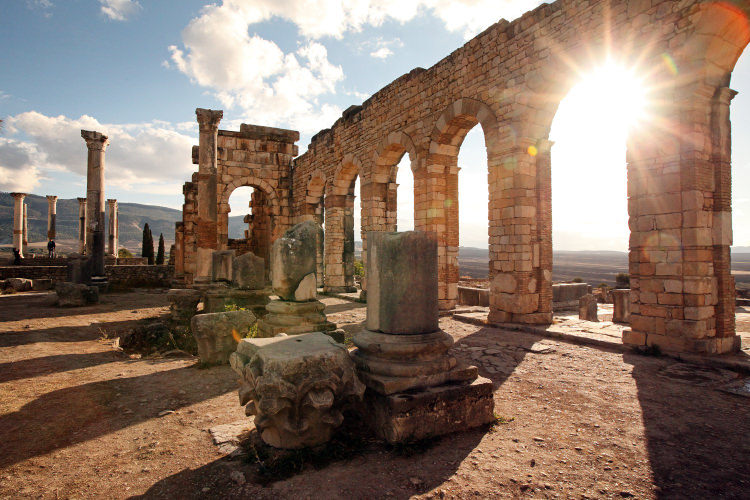
IV. Life in Roman Volubilis
Insight into the daily life and culture of the inhabitants of Volubilis
Volubilis, located in present-day Morocco, was a thriving Roman city from the 1st to 3rd centuries AD. The ruins of this ancient city provide valuable insights into its inhabitants' daily life and culture. Here are some key aspects:
1. Architecture: Volubilis boasted impressive architecture, including large houses, public buildings, and elaborate mosaics. These mosaics depicted various scenes from mythology, daily life, and nature, showcasing the artistic talent of the inhabitants.
2. Roman Influence: As a Roman city, Volubilis adopted many aspects of Roman culture, such as language, social customs, and religious practices. The inhabitants worshipped Roman gods and followed Roman laws, reflecting the assimilation of Roman influence.
3. Economy: Volubilis thrived economically due to its fertile agricultural lands. The residents grew crops such as olives, wheat, and grapes and produced olive oil and wine, which were exported throughout the Roman Empire. The city was also known for its craftsmanship, producing pottery, jewellery, and textiles.
4. Social Life: The inhabitants of Volubilis enjoyed a bustling social life, with public gatherings, theatre performances, and gladiatorial games held in the city's amphitheatre. The Roman baths provided a space for relaxation and socializing, where residents could bathe and converse.
Examination of the social and economic aspects of the city
Social Structure: Volubilis had a hierarchical social structure, with the ruling elite living in luxurious houses and enjoying a high standard of living. The middle class consisted of merchants, artisans, and skilled workers, while the lower class comprised labourers and slaves.
Economic Prosperity: The city's economic prosperity was evident in its buildings' grandeur and inhabitants' lifestyles. The wealth generated from agriculture and trade allowed for the construction of elaborate structures and the patronage of art and cultural activities.
Trade and Commerce: Volubilis was strategically located along major trade routes, contributing to its economic success. It was a hub for exchanging goods between the Mediterranean, sub-Saharan Africa, and other parts of the Roman Empire. Traders brought spices, textiles, and precious metals, enriching the city's cultural landscape.
Multiculturalism: As a melting pot of different cultures and ethnicities, Volubilis was home to a diverse population. Roman citizens, indigenous Berbers, and various other groups coexisted, contributing to the city's vibrant and multicultural society.
Decline: The decline of Volubilis began in the 3rd century AD, as the Roman Empire faced various challenges. The city gradually lost its economic importance, and by the 5th century, it was abandoned and fell into ruin.
Today, the ruins of Volubilis stand as a testament to the city's rich history and Roman influence in Morocco. The well-preserved mosaics and structures provide a glimpse into the daily life, culture, and economic prosperity of this ancient Roman city. Visiting Volubilis allows travellers to step back in time and appreciate the legacy of the Roman civilization.
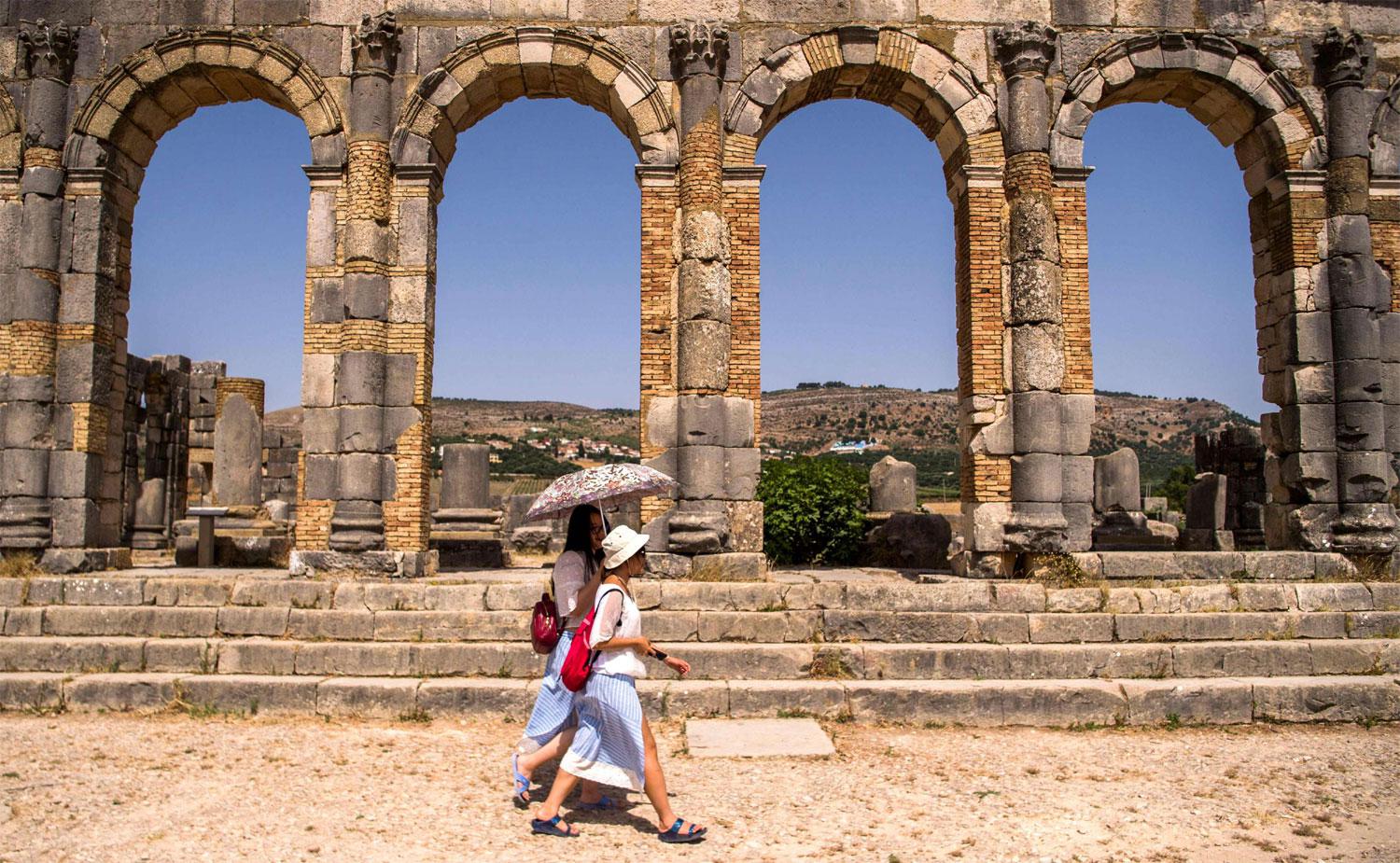
V. Decline and Preservation of Volubilis
Causes of decline and abandonment of the site
After centuries of prosperity, Volubilis eventually declined and was abandoned due to several factors:
1. Barbarian Invasions: In the 3rd century CE, the region was repeatedly attacked by Germanic tribes and ultimately fell under the control of the Vandals. These invasions disrupted the Roman administration and economy, leading to a decline in the city's prosperity.
2. Economic and Political Changes: The decline of the Western Roman Empire in the 4th and 5th centuries further contributed to the abandonment of Volubilis. As the empire grew weaker and faced internal conflicts, it became increasingly difficult to maintain control over distant provinces like Mauretania Tingitana.
3. Natural Disasters: Volubilis was also affected by natural disasters, including earthquakes and floods, which damaged the city's infrastructure and reduced its viability as a thriving urban centre.
Efforts made for the preservation and restoration of Volubilis
In the early 20th century, efforts were made to preserve and restore the ruins of Volubilis, recognizing its historical and cultural significance. Some of the notable initiatives include:
1. Excavation and Research: Extensive archaeological excavations were conducted at Volubilis in the early 20th century. These excavations, led by French and Moroccan archaeologists, have provided valuable insights into the city's layout, architecture, and daily life during the Roman period.
2. UNESCO World Heritage Site: In 1997, Volubilis was designated as a UNESCO World Heritage Site, recognizing its outstanding universal value and the need for its preservation. This designation has helped raise awareness about the historical importance of the site and the need for its protection.
3. Restoration Projects: Restoration work has been done to preserve and showcase some of the city's most significant structures. The triumphal arch, basilica, and several houses have been restored to give visitors a glimpse of the city's former grandeur.
4. Museum: A museum was constructed near the site to house and display the numerous artefacts and mosaics unearthed during the excavations. The museum provides visitors with a deeper understanding of Volubilis' history and the daily life of its inhabitants.
Today, Volubilis stands as one of the best-preserved Roman ruins in Morocco, offering a captivating glimpse into the country's ancient past. Its rich history, impressive architecture, and stunning mosaics continue to inspire visitors from around the world.
To know more about Volubilis and its fascinating history, you can visit its Wikipedia page.
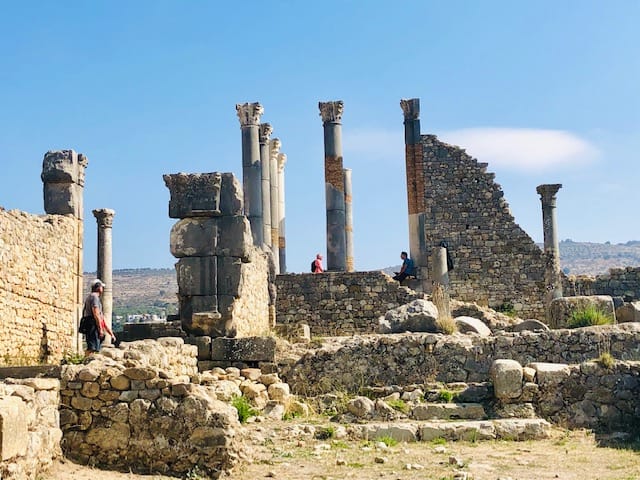
VI. Visiting Volubilis Today
Visiting Volubilis is like stepping back in time to explore the incredible ancient Roman ruins in Morocco. Here are some travel tips and practical information to help you make the most of your trip to Volubilis.
Travel tips and practical information for visiting Volubilis
1. Getting there: Volubilis is located near Meknes in northern Morocco. The closest airport is Fes-Saïss Airport, which is around 50 kilometres away. You can take a taxi or hire a private car to reach Volubilis. Alternatively, you can take a bus from Meknes or Fes to the site.
2. Entrance fees: As of 2023, the entrance fee for Volubilis is 70 Moroccan Dirhams, which is about USD 7.50. This fee allows you access to explore the archaeological site and museum. Bringing cash in the local currency is recommended to pay for the entrance fee.
3. Opening hours: Volubilis is open daily from 8:30 AM to 5:45 PM. It's advised to arrive early in the morning to avoid crowds and have ample time to explore the site.
4. Guided tours: Hiring a guide is highly recommended to gain a deeper understanding of the history and significance of Volubilis. Local guides can provide valuable insights and highlight significant features and details you might otherwise miss.
5. Comfortable footwear and clothing: Exploring Volubilis involves walking on uneven terrain, so wearing comfortable shoes is essential. Also, pack sunscreen, a hat, and sunglasses, as the site can get quite hot during the day.
Highlights of the must-see sights and experiences in the archaeological site
• Triumphal Arch: The Triumphal Arch of Caracalla is one of the most iconic structures in Volubilis. It's an impressive monument that once served as the entrance gate to the city.
• Decumanus Maximus: This main street of Volubilis is lined with ruins of ancient shops, houses, and public buildings. Stroll along the Decumanus Maximus to get a sense of the layout and daily life in a Roman city.
• House of Orpheus: Explore the well-preserved House of Orpheus, a grand Roman residence decorated with intricate mosaics. Admire the vibrant colours and detailed designs that depict mythological scenes.
• Capitol: The Capitol was the religious and civic centre of Volubilis, featuring two temples dedicated to Jupiter and Juno. The ruins of these temples can still be seen today, along with the basilica and other Roman civic buildings.
• Basilica: The Basilica of Volubilis was a public building used for administrative and legal purposes. Marvel at the remaining columns and explore the ruins of this important structure.
Visiting Volubilis offers a unique opportunity to witness the impressive architectural heritage of ancient Rome in Morocco. Don't forget to bring your camera to capture the stunning mosaic art and picturesque views of the surrounding countryside.
